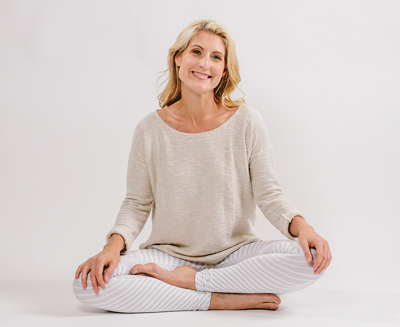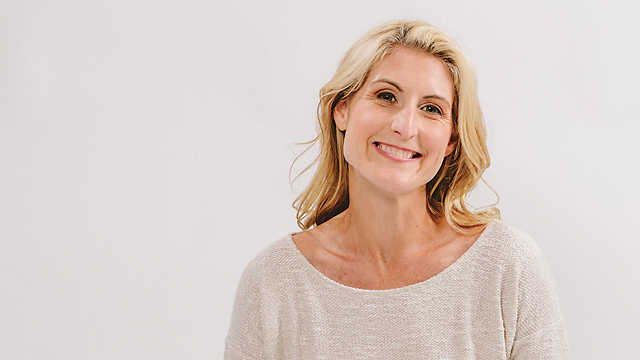Four years ago, my spiritual journey began when I made the decision to stop drinking and start meditating. Examining what I call my inner landscape led to a compassionate understanding of my authentic self. This soulful encounter transformed my relationship with my children, as I began to weave meditation into the fabric of our family. Our children are now five, eight, and eleven years old, and meditation is part of our nightly routine – a time and space to breathe, reflect and spend valuable one-on-one time.
Mindfulness allows us to view ourselves with the same loving compassion we extend to our children. As a mother of three, this thought resonated with me. Although it is a prerequisite for peace and happiness, self-love is not pre-programmed in our children. Our society rewards appearance and performance, attaining and achieving, as opposed to authenticity and generosity. At a young age, our kids are given messages about the necessity of self-improvement: Hard work and determination are the keys to becoming the best you can be. The implication is that they are not good enough as they are; they must prove their self-worth – in school, on the playing fields, on the stage, and in the social arena. Developing the mind happens at the expense of tending to the heart.
Mindfulness allows us to bridge this disconnect between the heart and mind in modern society.
Jon Kabat-Zinn was the first to integrate Buddhist teachings with science and apply mindfulness as a compassionate means to cope with stress, anxiety, pain, and illness. He used functional magnetic resonance imaging (fMRI) technology and neuroscience to document how meditation changes not only the pathways in the brain, but the gray matter of the brain itself.
Mindfulness-based stress reduction programs are now implemented across the globe in medical institutions, hospitals, and corporations. In this day and age of quick fixes, medication, and addiction, mindfulness provides a lasting and nourishing mind-body-spirit alternative. As Kabat-Zinn explains: “In Asian languages, the word for ‘mind’ and the word for ‘heart’ are the same. So if you’re not hearing mindfulness in some deep way as heartfulness, you’re not really understanding it.” Thus, mindfulness is both a training of the mind and cultivation of the heart.
As a parent, I view my role as that of facilitator, creating an environment in which my children are able to connect with and manifest their authentic selves. As they navigate this climate of overwhelming stress, stimulation, and competition, my intention is to equip them with the skills to chart their course according to their inner compasses. Naturally, I gravitate toward mindfulness as a foundational element in understanding my role. Just as teachers tend to be more effective based on the depth of their understanding of the subject matter, parents should establish a mindfulness practice themselves before introducing the concept to their children.

Here are two simple ways to incorporate mindfulness into your daily routine:
1. Formal Seated Practice
I suggest starting with guided meditation. There are a variety of apps you might investigate, such as Insight Timer (it’s free, and has wonderful meditations for children) or Headspace that will help you.
Pick a time of day that works for you, and start with ten minutes. Choose a quiet spot where you will not be disturbed. Find a comfortable position – either cross-legged on a cushion on the floor, lying down, or seated in a chair with your feet planted. If seated, root your sitz bones down and extend your spine as if being pulled upward by an invisible thread extending from the top of your head. Relax your shoulders down your back. Close your eyes. Tune into your breathing. Thoughts will come. The mind is programmed to think, just as the lungs are programmed to breathe. Focus on the breath and allow the thoughts to drift by like clouds in the sky – without judging them or attaching to them. Either continue focusing on your breath or on the words from the guided meditation. Don’t be hard on yourself. Starting to meditate is not easy, but it gets easier with time as your brain begins to change. That’s why it is called practice!
2. Informal Practice
You can use everyday activities as opportunities to practice mindfulness by tuning into the senses. We have five senses: sight, sound, taste, touch, and smell. When we focus on engaging our senses, we cultivate beginner’s mind and transform ordinary acuities into extraordinary experiences. For example, try eating a clementine mindfully. Observe the clementine as if for the first time, its color, shape, size, and texture. Close your eyes and feel the clementine, and notice what your fingers tell you. Bring the clementine to your nose, inhaling the fragrance deeply. Start to peel the clementine, tuning into the sound of the peel separating from the flesh. Smell the clementine once more, noticing the difference. Gingerly separate one section, and carefully and slowly begin to chew, savoring each bite as if it were your first and last. Take as much time as you can on this exercise. This is one example of many. You might also apply this informal practice of mindfulness to washing your hands, taking a shower, walking, doing the dishes, or some other housework. This may seem contrived or hokey at first, but eventually, it becomes habit and can serve as a valuable respite from the frenetic pace of life.
I believe mindfulness is one of the most valuable gifts we can give our children as they navigate the perilous path of individuation. Once you feel comfortable with practicing mindfulness every day, you’ll be ready to guide your children in becoming mindful. You can lead them in the same steps you took to incorporate mindfulness in your life. By practicing mindfulness ourselves and helping them practice it, we equip our kids with skills to combat anxiety and cultivate resiliency, and we enable them to rest in self-awareness and compassionate self-acceptance. Rather than resisting who they really are and trying to become something else, children can learn to care for themselves as they are. With mindfulness, we empower our children to discover and manifest their true selves.




